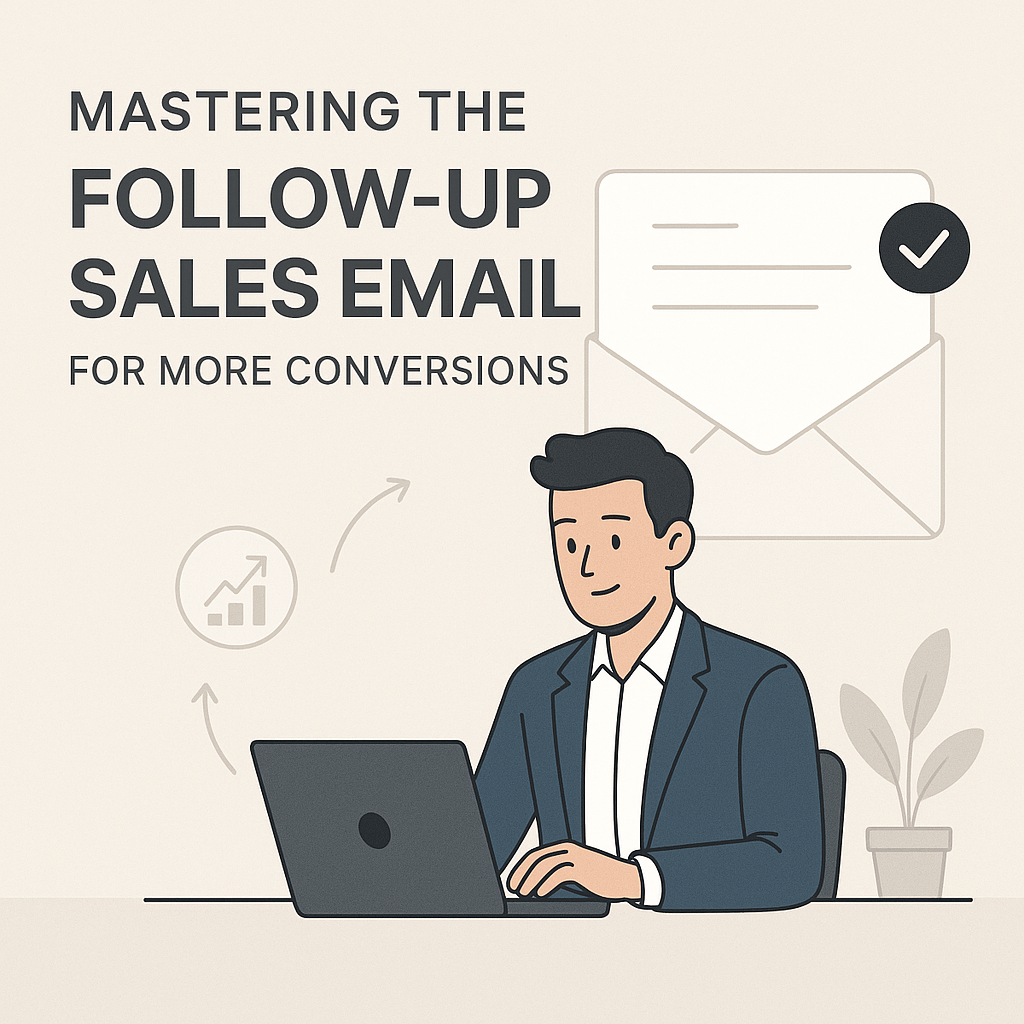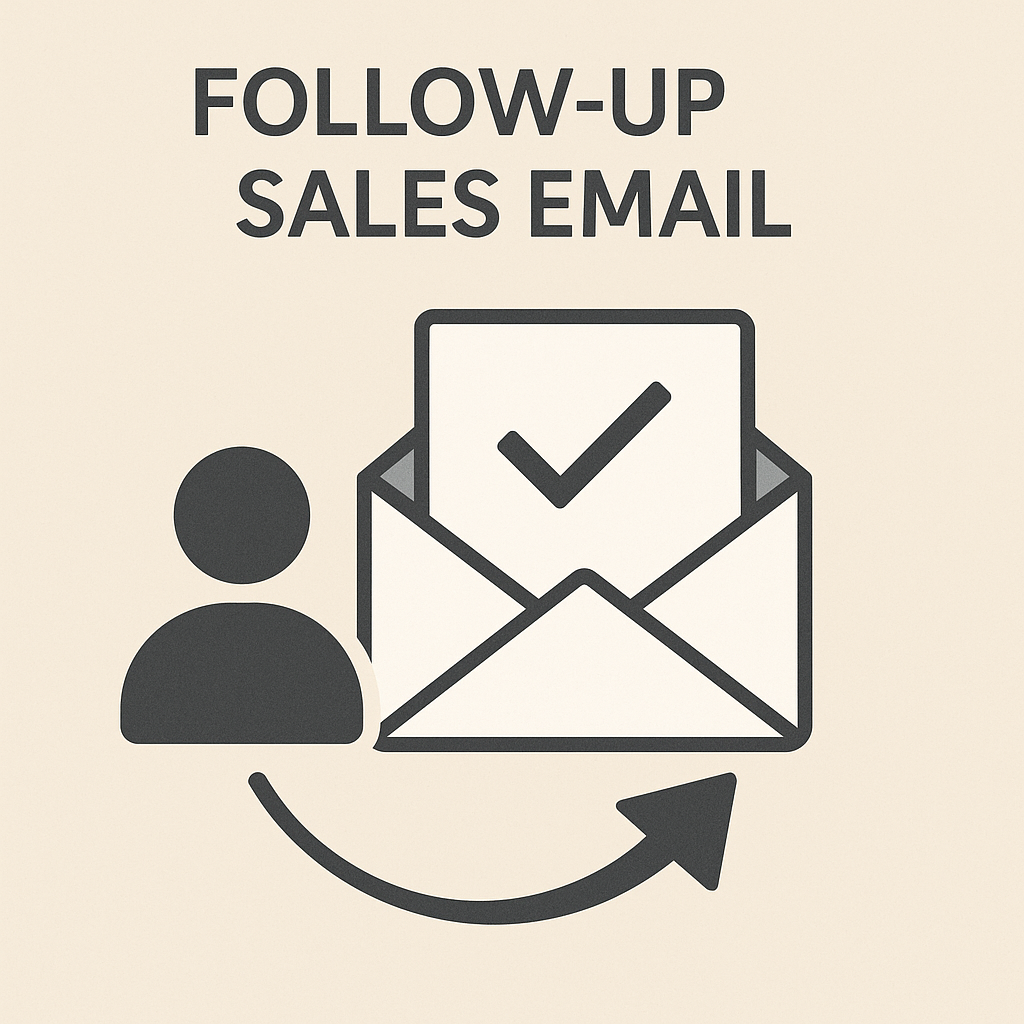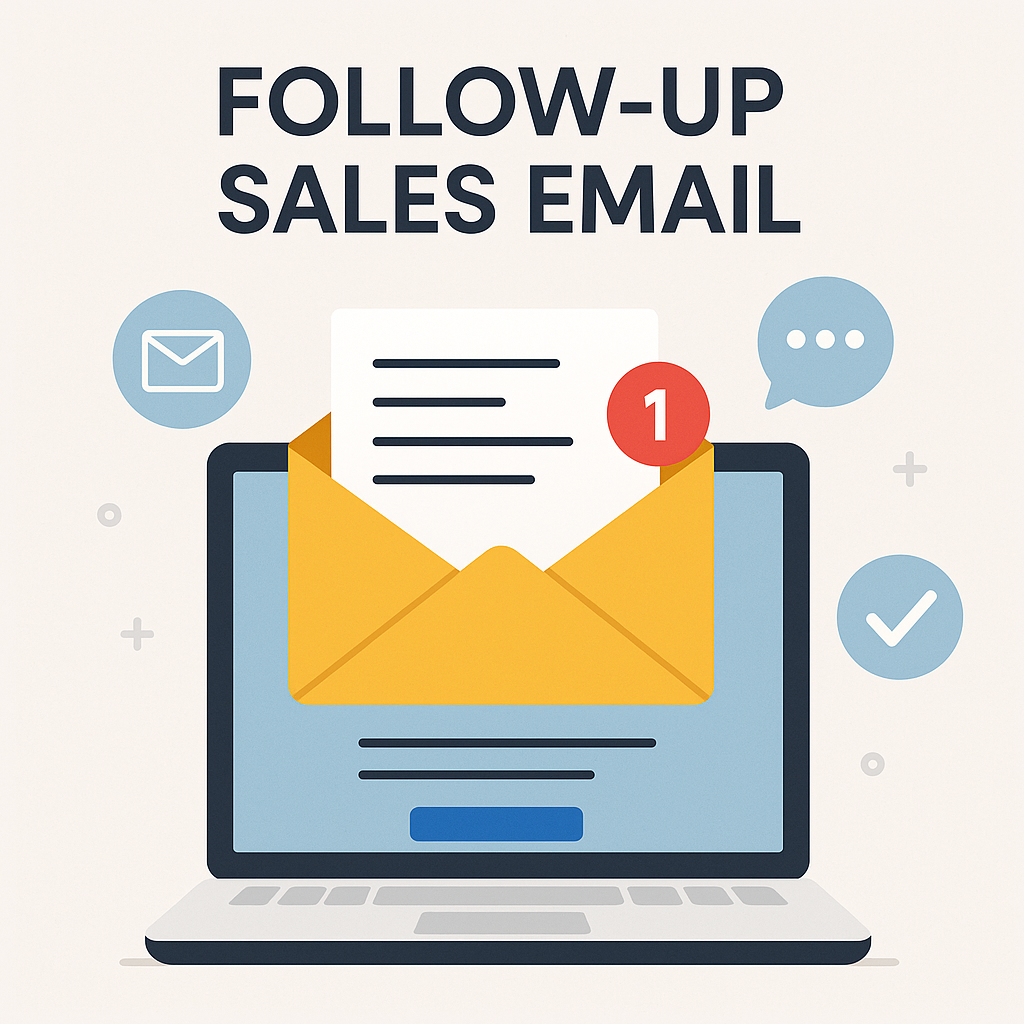Mastering the Followup Sales Email for More Conversions

In the dynamic world of sales, the initial interaction is often just the beginning. The real magic, and where most deals are won, happens in the follow-up. Yet, for many sales professionals, entrepreneurs, and busy executives, mastering the followup sales email remains a persistent challenge. Low response rates, the sheer time commitment of manual outreach, and the struggle to craft messages that truly resonate can feel like insurmountable hurdles. But what if we told you that the key to unlocking higher conversion rates and exponential revenue growth lies not just in persistence, but in strategic, value-driven communication?
This comprehensive guide dives deep into the art and science of the followup sales email. We'll move beyond generic templates and explore how intelligent email management can transform your sales pipeline from a leaky sieve into a powerful conversion engine. Get ready to learn how to craft compelling messages, leverage cutting-edge automation, and harness the power of artificial intelligence to elevate your outreach and achieve unparalleled success.
Why Followup Sales Emails Are Non-Negotiable for Growth
The notion that a single email or call will close a deal is largely a myth. In today's competitive landscape, prospects are bombarded with information, and their inboxes are overflowing. This makes consistent, strategic follow-up not just important, but absolutely essential for driving growth and revenue.
The Startling Statistics of Follow-Up Effectiveness
Consider these compelling figures that underscore the importance of relentless, yet smart, follow-up:
- The Multi-Touchpoint Reality: According to various sales studies, a significant majority of sales don't happen after the first interaction. In fact, many sources suggest that most deals close after the fifth, sixth, or even twelfth touchpoint. This means if you stop after one or two emails, you're leaving substantial revenue on the table. Most sales don't happen until the fifth or sixth touchpoint, highlighting the critical role of sustained engagement.
- Deals Die from Neglect: A staggering percentage of promising leads go cold simply because of a lack of consistent follow-up. Sales professionals are often busy, but neglecting a lead for even a few days can mean losing them to a more proactive competitor.
- Revenue Impact: Companies with well-defined and executed follow-up strategies consistently report higher conversion rates, shorter sales cycles, and significantly increased lifetime customer value. It's not just about closing more deals; it's about building stronger relationships that lead to repeat business and referrals.
Moving Beyond Persistence to Strategic Engagement
The goal of a followup sales email isn't just to "check in." It's about providing continuous value, addressing potential concerns, reinforcing your unique selling proposition, and gently guiding the prospect through their buying journey. It's about demonstrating that you understand their needs and are committed to helping them find a solution. This strategic approach transforms your follow-up from an annoying poke into a welcome, helpful interaction, directly impacting your conversion rate optimization email efforts.
Anatomy of an Effective Followup Sales Email
Crafting a compelling followup sales email is an art form, but one that can be mastered by adhering to a few core principles. Each element plays a crucial role in capturing attention and driving action.
1. Compelling Subject Lines: The Gateway to Your Message
Your subject line is your first, and often only, chance to make an impression. It needs to be clear, concise, and intriguing enough to warrant an open. Avoid generic phrases like "Following Up" or "Checking In." Instead, try:
- Personalization: "Quick Question, [Prospect's Name]?" or "Idea for [Company Name] Regarding [Pain Point]"
- Value-Oriented: "Here's that resource we discussed" or "Boosting [Metric] for [Company Name]"
- Urgency/Curiosity: "Thought you might find this useful" or "Next Steps for [Project]"
2. Clear Purpose and Context
Immediately remind the recipient of your previous interaction. Whether it was a meeting, a phone call, a downloaded resource, or a previous email, provide context to jog their memory. State the purpose of your email upfront – are you sharing information, asking a question, or suggesting a next step?
3. Personalized and Value-Driven Content
This is where you differentiate yourself. Generic, templated emails rarely convert. Leverage information you've gathered about the prospect's needs, challenges, and goals. Reference specific points from your last conversation. The content should always offer value, whether it's:
- A relevant case study or success story
- An insightful article or resource related to their industry or pain point
- A tailored solution addressing a specific challenge they face
- An answer to a question they raised
Show, don't just tell, how your product or service can solve their problems.
4. Strong, Clear Call to Action (CTA)
Every followup sales email needs a single, clear call to action. Don't overwhelm the prospect with too many choices. Make it incredibly easy for them to take the next step. Examples include:
- "Would you be open to a 15-minute chat next week?"
- "What does your calendar look like for a quick demo on [Date]?"
- "Reply to this email if you'd like to explore this further."
- "Click here to download the full report."
5. Professional and Concise Tone
Maintain a professional yet friendly tone. Be concise and respect their time. Get straight to the point, deliver value, and clearly state your ask. Avoid overly aggressive or desperate language. Remember, you're building a relationship, not just pushing a sale.
Strategic Follow-Up Sequences: Timing and Purpose
The "when" and "why" of your follow-up are just as crucial as the "what." Different scenarios call for different timing and messaging strategies. Implementing thoughtful automated sales sequences is key to consistency.
Different Follow-Up Scenarios and Their Optimal Timing
- Post-Initial Contact/Meeting:
- Timing: Within 24 hours.
- Purpose: Reiterate key discussion points, thank them for their time, provide any promised resources, and propose a clear next step. This email sets the tone and keeps the momentum going.
- After No Response to Initial Outreach:
- Timing: 2-3 days after the first email.
- Purpose: Briefly re-state your value proposition, perhaps with a new angle or a different piece of relevant content. Keep it short and easy to digest.
- After Sending a Proposal/Quote:
- Timing: 1-2 days after sending the proposal.
- Purpose: Confirm receipt, ask if they have any initial questions, and offer to walk them through it. A follow-up here can feel intimidating, but it's crucial. Following up after sending a quote is the moment of truth.
- Objection Handling/Addressing Concerns:
- Timing: Immediately after an objection is raised or within 24 hours if it requires research.
- Purpose: Directly address their concern with empathy and provide a solution or clarification. This shows you're listening and committed to resolving their issues.
- Nurturing (Long-Term Prospects):
- Timing: Weekly, bi-weekly, or monthly, depending on the sales cycle.
- Purpose: Provide ongoing value through relevant industry insights, new product updates, success stories, or invitations to webinars. Keep your brand top-of-mind without being pushy.
- "Breakup" Email:
- Timing: After 5-7 non-responsive emails over several weeks.
- Purpose: This is a final, polite email to close the loop. It often prompts a response (even if it's "not interested") because it creates a sense of finality.
Frequency: Finding the Sweet Spot
There's no universal magic number for follow-up emails, as it depends on your sales cycle, industry, and the prospect's engagement level. However, a common pattern might look like this:
- Day 1: Initial follow-up (post-meeting/call)
- Day 3: Value-add, gentle nudge
- Day 7: New angle, relevant resource
- Day 14: Case study, social proof
- Day 21-30: "Breakup" email or transition to long-term nurturing
The key is to be persistent without being annoying. Every email should offer new value or a fresh perspective. Remember, in sales, following up is a must—a constant must. Use effective follow-up techniques to guide leads, not push them.
Leveraging Automation and CRM for Seamless Follow-Ups
The idea of manually sending dozens, if not hundreds, of personalized follow-up emails can be daunting. This is where sales email automation and robust CRM integration become game-changers, transforming your email management software into a powerful engine.
The Power of Sales Email Automation Tools
Automation platforms allow you to pre-schedule sequences of emails that are triggered by specific events (e.g., a prospect downloading an ebook, attending a webinar, or failing to respond to an initial outreach). Benefits include:
- Time Savings: Free up valuable time for more complex sales activities, like discovery calls and closing deals.
- Consistency: Ensure every lead receives timely, relevant follow-ups, reducing the chance of leads falling through the cracks.
- Scalability: Manage hundreds or thousands of leads without increasing your manual workload.
- Personalization at Scale: While automated, these tools allow for dynamic personalization fields, making each email feel tailored to the recipient.
Seamless CRM Email Integration for Sales Pipeline Management
Integrating your email automation with your CRM system (e.g., Salesforce, HubSpot, Zoho CRM) is crucial for effective sales pipeline management. This integration provides a unified view of your prospect's journey:
- Centralized Data: All email interactions, opens, clicks, and replies are logged directly in the CRM, giving sales reps a complete history.
- Automated Task Creation: Set up triggers to create tasks in your CRM when a prospect takes a specific action (e.g., opening an email multiple times, clicking a link), prompting a manual intervention.
- Improved Lead Scoring: Engagement data from emails can feed into your lead scoring model, helping you prioritize the hottest leads.
- Better Reporting and Analytics: Track the performance of your entire follow-up strategy, identifying what works and what needs improvement.
By combining automation with CRM, you create a powerful synergy that streamlines your communication software for business, ensures no lead is forgotten, and provides the insights needed to continuously optimize your sales process.
AI's Role in Revolutionizing Sales Follow-Ups
Artificial intelligence is no longer a futuristic concept; it's a practical tool revolutionizing how sales professionals approach the email follow-up best practices. From drafting emails to predicting optimal send times, AI is enhancing every aspect of the sales follow-up process, making it a critical component of modern email productivity tools.
How AI Elevates Your Follow-Up Game
- Content Generation and Optimization: AI-powered tools can assist with AI email drafting, helping you craft compelling subject lines, body copy, and calls to action. They can analyze your existing content and suggest improvements for clarity, conciseness, and persuasive power. Some even offer sentiment analysis to ensure your tone is appropriate.
- Hyper-Personalization at Scale: AI can analyze vast amounts of data—from CRM records to social media activity and public company information—to generate highly personalized email content that resonates with individual prospects. This goes far beyond simply inserting a name; it can tailor the value proposition, reference specific pain points, and even suggest relevant case studies automatically.
- Predictive Timing and Optimal Send Times: Leveraging machine learning, AI can analyze past engagement data (open rates, click-throughs, replies) for your specific audience and predict the best time to send a follow-up email for maximum impact. This ensures your message lands in the inbox when the prospect is most likely to open and engage.
- Engagement Analysis and Next-Step Recommendations: AI can monitor email engagement (opens, clicks, replies, time spent reading) and provide real-time insights. If a prospect opens an email multiple times but doesn't reply, AI might suggest a specific follow-up action or even flag them as a hot lead. Tools can even use AI to summarize lengthy email threads, turning inbox chaos into clarity.
Modern ai executive assistant platforms are at the forefront of this revolution, offering advanced features that integrate these AI capabilities directly into your workflow. They can help streamline your communications, analyze engagement, and even assist in managing your entire inbox, allowing you to focus on high-value sales activities rather than administrative tasks. This intelligent approach transforms inefficient sales outreach into a highly effective, scalable revenue-generating activity.
Common Follow-Up Mistakes and How to Avoid Them
Even with the best intentions and tools, it's easy to fall into common follow-up traps that can derail your efforts. Recognizing these pitfalls is the first step to avoiding them.
- Being Too Pushy or Desperate:
- Mistake: Sending multiple emails in quick succession, using aggressive language, or sounding desperate for a sale.
- Solution: Focus on providing value in each interaction. Space out your emails appropriately. If a prospect isn't responding, try a different angle or channel, or consider a "breakup" email rather than continuous nagging.
- Lacking Value in Each Touchpoint:
- Mistake: Sending generic "just checking in" emails that offer no new information or benefit to the prospect.
- Solution: Every follow-up email should have a clear purpose and deliver new value. This could be a relevant article, a new insight, a success story, or an answer to an unasked question.
- Poor or Non-Existent Personalization:
- Mistake: Sending mass emails without tailoring the content to the individual prospect's needs, industry, or previous interactions.
- Solution: Leverage all available information (CRM data, social media, company website) to personalize your message. Refer to specific pain points, previous conversations, or their company's recent achievements. Even with automation, personalization is key.
- Inconsistent Follow-Up:
- Mistake: Following up diligently for a few days, then dropping off the face of the earth, or having no structured follow-up plan.
- Solution: Implement automated sales sequences and use your CRM to ensure consistent and timely follow-ups. A well-defined email spam filter strategy also ensures your messages land in the right inbox.
- Unclear or Missing Call to Action:
- Mistake: Leaving the prospect wondering what they should do next, or providing too many options.
- Solution: Always include a single, clear, and easy-to-understand call to action. Make it effortless for the prospect to take the next step.
Measuring Success and Iterating Your Follow-Up Strategy
To truly master the followup sales email, you must adopt a data-driven approach. Guesswork won't cut it. Continuously tracking, analyzing, and refining your strategy is essential for ongoing improvement and higher conversion rate optimization email.
Key Metrics to Track
- Open Rates: This tells you how effective your subject lines are. A low open rate indicates your subject line isn't compelling enough or your email isn't reaching the inbox (check for deliverability issues).
- Click-Through Rates (CTR): This measures how many people clicked on links within your email. A high CTR indicates your content is engaging and your call to action is clear.
- Reply Rates: This is a direct indicator of engagement and interest. A good reply rate means your message is resonating and prompting a response.
- Conversion Rates: Ultimately, this is the most important metric. How many follow-up sequences led to a demo, a discovery call, a closed deal, or another desired outcome?
- Time to Conversion: How long does it take from the first follow-up to a conversion? Shorter times indicate more efficient sequences.
How to Iterate and Refine Your Approach
- A/B Testing: Experiment with different subject lines, body copy, calls to action, and even send times. Send version A to one segment of your audience and version B to another, then compare the results.
- Analyze Performance by Sequence: Don't just look at individual emails. Analyze the performance of entire follow-up sequences. Which sequence leads to the highest reply or conversion rate?
- Segment Your Audience: Different prospect segments might respond better to different messages or timings. Tailor your follow-up strategies based on industry, company size, role, or specific pain points.
- Gather Feedback: Don't be afraid to ask prospects (even those who didn't convert) for feedback on your communication.
- Stay Updated: The landscape of email marketing and sales is constantly evolving. Keep an eye on new trends, tools, and strategies for faster email responses.
By consistently monitoring these metrics and being willing to adapt, you can fine-tune your followup sales email strategy, ensuring it becomes an increasingly powerful tool in your sales arsenal.
Conclusion
Mastering the followup sales email is no longer an option; it's a fundamental requirement for sustainable growth in today's competitive sales environment. By understanding the strategic importance of consistent, value-driven communication, you can transform lukewarm leads into eager customers. We've explored the anatomy of an effective email, the nuances of strategic timing and sequencing, and the immense power of leveraging AI for sales emails and automation tools.
Remember, it's about moving beyond mere persistence to smart, empathetic engagement. By avoiding common pitfalls and committing to a data-driven approach, you can continuously refine your email follow-up best practices. The result? Improved conversion rates, shortened sales cycles, and a more robust, efficiently managed sales pipeline.
It's time to stop leaving money on the table. Start implementing these strategies today, and watch your revenue soar. Your sales success is just a few well-crafted follow-up emails away.



